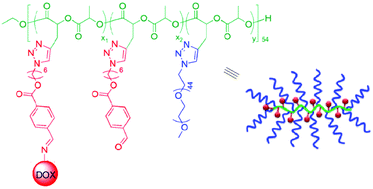A degradable brush polymer–drug conjugate for pH-responsive release of doxorubicin
Abstract
To achieve high precision and efficacy in disease treatment, biodegradability and environmental responsivity are highly desired in drug delivery systems. Having a polylactide (PLA)-based biodegradable scaffold conjugated with doxorubicin (DOX) moieties via pH-responsive linkages, a brush polymer–drug conjugate (BPDC) was synthesized and studied. The biodegradable scaffold, PLA-graft-aldehyde/polyethylene glycol (PLA-g-ALD/PEG), was prepared via a copper-catalyzed alkyne–azide click reaction. Subsequently, the BPDC was obtained by conjugating doxorubicin with the scaffold through an acid-sensitive Schiff base linkage. The well-controlled structures of the resulting BPDC and its precursors were verified by proton nuclear magnetic resonance and gel permeation chromatography characterization. As revealed by dynamic light scattering and transmission electron microscopy, the BPDC had a well-defined nanostructure with the size of 10–30 nm. A drug release study of the BPDC demonstrated a much faster release of DOX at the pH of 5.5 than at the pH of 7.4. Both cell internalization and cytotoxicity studies of the BPDC in MCF-7 breast cancer cells indicated its significant potential for application as a novel anticancer nanomedicine.


 Please wait while we load your content...
Please wait while we load your content...